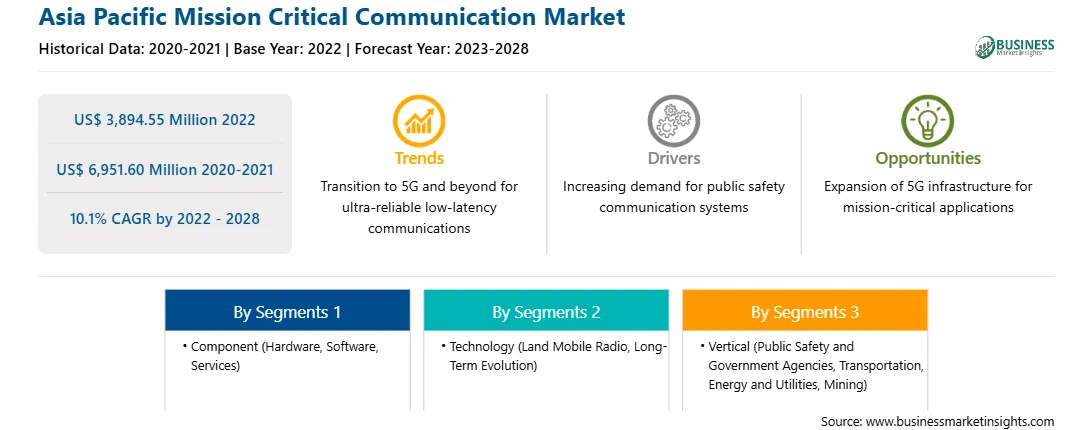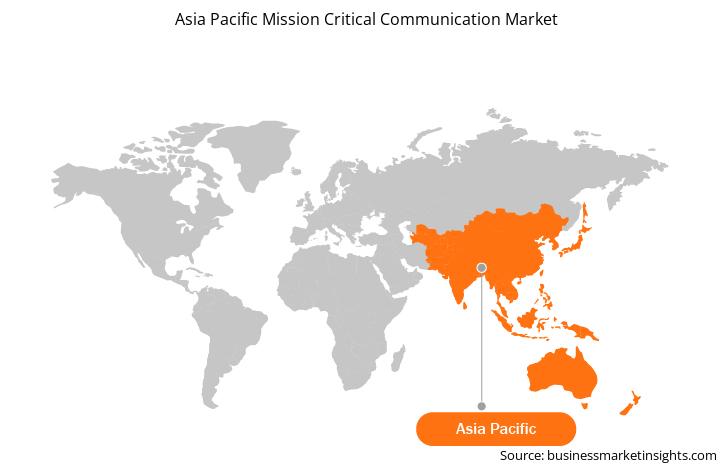Companies operating in the mission critical communication market in Asia Pacific have increased their investments in the development of new and advanced systems and solutions, in response to the growing demands across end-use industries such as public safety and government, transportation, energy & utilities, mining, and defense. Motorola Solutions, Inc.; Nokia; Thales Group; Ericson; and Hytera Communication Corp Ltd are among the key players operating in the market. In March 2019, Motorola Solutions introduced the MiT5000, a new digital convenience radio for Japan. The device provides great sound and functionality for a wide range of professional needs in industries such as hospitality, manufacturing, construction, logistics, and security. The MiT5000 has high-quality, easy-to-hear audio and a volume slider that filters out background noise automatically. In August 2020, Hytera Communication Corp Ltd launched a carrier-integrated mission critical version of its Push-to-Talk over Cellular (PoC) broadband solution. Hytera HyTalk MC, which is an end-to-end solution for mission- and business-critical communications, supports 3GPP Mission Critical Push-to-Talk (MCPTT), Mission Critical Data (MCData), and Mission Critical Video (MCVideo) services. Thus, a rise in investments by manufacturers in new product developments is propelling the growth of the mission critical communication market in Asia Pacific.
Strategic insights for the Asia Pacific Mission Critical Communication provides data-driven analysis of the industry landscape, including current trends, key players, and regional nuances. These insights offer actionable recommendations, enabling readers to differentiate themselves from competitors by identifying untapped segments or developing unique value propositions. Leveraging data analytics, these insights help industry players anticipate the market shifts, whether investors, manufacturers, or other stakeholders. A future-oriented perspective is essential, helping stakeholders anticipate market shifts and position themselves for long-term success in this dynamic region. Ultimately, effective strategic insights empower readers to make informed decisions that drive profitability and achieve their business objectives within the market.

| Report Attribute | Details |
|---|---|
| Market size in 2022 | US$ 3,894.55 Million |
| Market Size by 2028 | US$ 6,951.60 Million |
| Global CAGR (2022 - 2028) | 10.1% |
| Historical Data | 2020-2021 |
| Forecast period | 2023-2028 |
| Segments Covered |
By Component
|
| Regions and Countries Covered | Asia-Pacific
|
| Market leaders and key company profiles |
The geographic scope of the Asia Pacific Mission Critical Communication refers to the specific areas in which a business operates and competes. Understanding local distinctions, such as diverse consumer preferences (e.g., demand for specific plug types or battery backup durations), varying economic conditions, and regulatory environments, is crucial for tailoring strategies to specific markets. Businesses can expand their reach by identifying underserved areas or adapting their offerings to meet local demands. A clear market focus allows for more effective resource allocation, targeted marketing campaigns, and better positioning against local competitors, ultimately driving growth in those targeted areas.

The Asia Pacific mission critical communication market is segmented on the basis of component, technology, vertical, and country. Based on component, the market is segmented into hardware, software, and services. In 2022, the hardware segment is estimated to dominate the market. The market for mission critical communication hardware is further segmented into command and control centers, routers and gateways, and distribution management systems. In 2022, the distribution management system segment is expected to dominate the market for hardware. Based on technology, the Asia Pacific mission critical communication market is categorized into land mobile radio (LMR) and long-term evolution. In 2022, the long-term evolution segment is likely to lead the market. Based on vertical, the Asia Pacific mission critical communication market is segmented into public safety and government agencies, transportation, energy and utilities, mining, and others. In 2022, the public safety and government agencies segment is expected to dominate the market. The Asia Pacific mission critical communication market, based on country, is segmented into Australia, China, India, Japan, South Korea, and rest of Asia Pacific. In 2022, China dominated the market.
Key players dominating the Asia Pacific mission critical communication market are Ascom; Huawei Technologies Co. Ltd.; Hytera Communication Corporation Limited; L3Harris Technologies, Inc.; Motorola Solutions, Inc.; Nokia Corporation; Tassta GmbH; Telefonaktiebolaget LM Ericsson; and Zenitel.
The Asia Pacific Mission Critical Communication Market is valued at US$ 3,894.55 Million in 2022, it is projected to reach US$ 6,951.60 Million by 2028.
As per our report Asia Pacific Mission Critical Communication Market, the market size is valued at US$ 3,894.55 Million in 2022, projecting it to reach US$ 6,951.60 Million by 2028. This translates to a CAGR of approximately 10.1% during the forecast period.
The Asia Pacific Mission Critical Communication Market report typically cover these key segments-
The historic period, base year, and forecast period can vary slightly depending on the specific market research report. However, for the Asia Pacific Mission Critical Communication Market report:
The Asia Pacific Mission Critical Communication Market is populated by several key players, each contributing to its growth and innovation. Some of the major players include:
The Asia Pacific Mission Critical Communication Market report is valuable for diverse stakeholders, including:
Essentially, anyone involved in or considering involvement in the Asia Pacific Mission Critical Communication Market value chain can benefit from the information contained in a comprehensive market report.